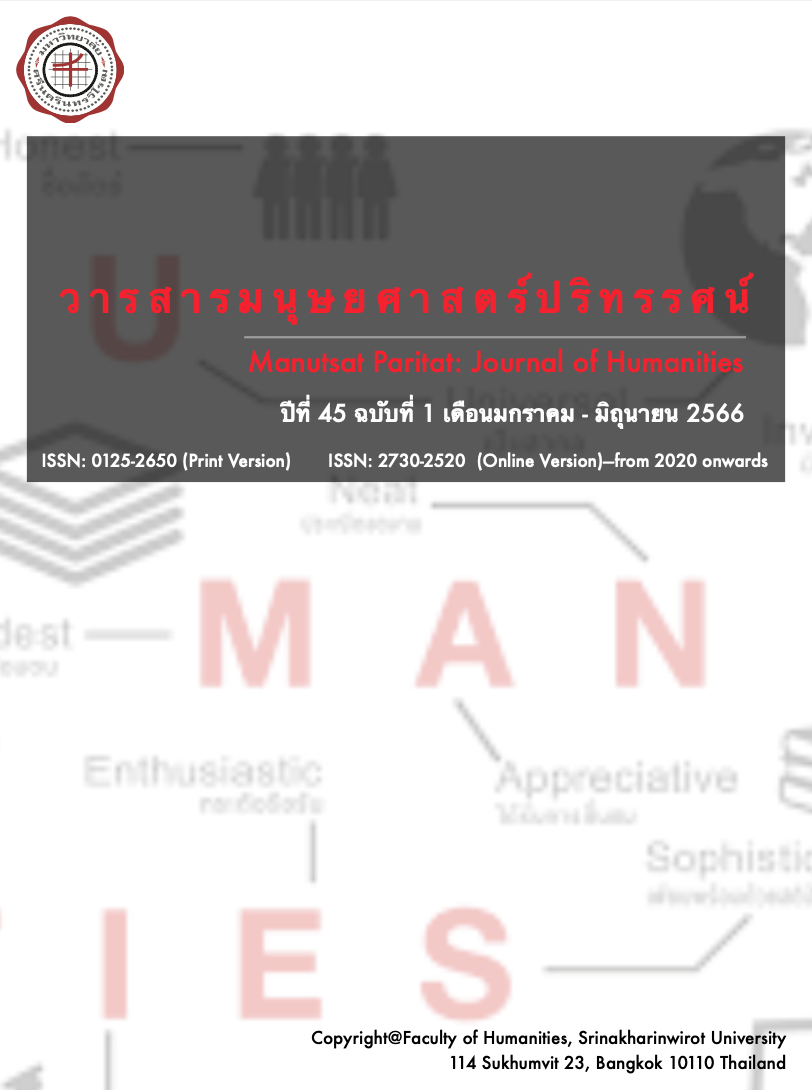The Adaptation of the Character of Empress Dowager Cixi and its Historical Perspectives: Novel and TV Drama “Cang Qiong Zhi Mao”
Main Article Content
Abstract
The purpose of this research is to examine the strategies and the reasons for the adaptation of "Empress Dowager Cixi", a character from the Japanese novel, Cang Qiong Zhi Mao to the Chinese historical TV drama broadcasted in 2010. The concepts of literary adaptation and whitewashing as well as Chinese and Japanese historical perspectives on “Empress Dowager Cixi” are adopted as a conceptual framework for this research. The findings reveal some similarities and differences between the two versions. The three similar images of "Empress Dowager Cixi" were found in the Japanese novel version and the Chinese TV drama version. These include 1.) the mother who loves and cares for a child, 2.) the skillful ruler who is loved by the people, and 3.) an ordinary human. The differences were found in adaptation through the use of modification strategy. Some details, such as the characters’ personalities in the TV drama version were found to be modified because of the different historical perspectives between the TV producer and the novel’s author. The image of the “Empress Dowager Cixi” in the novel version may be whitewashed. This could be the reason why the TV drama version had to adapt this character to suit China's historical perspectives.
Article Details

This work is licensed under a Creative Commons Attribution-NonCommercial-NoDerivatives 4.0 International License.
Any unauthorized copying, publication, reproduction or distribution of copyrighted works appeared in Manutsat Paritat: Journal of Humanities is an infringement of the copyright owners’ rights. To authorize the copying, publication, reproduction or distribution of copyrighted works to be appeared in other printed materials or any online media, please write to MPJHthaijo@gmail.com for permission.
References
คณะอนุกรรมการพิจารณาเกณฑ์การถอดเสียงภาษาจีนเป็นภาษาไทย สำนักเลขาธิการนายกรัฐมนตรี. (2543). เกณฑ์การ ถอดเสียงภาษาจีนแมนดารินด้วยอักขรวิธีไทย. ปทุมธานี: โรงพิมพ์มหาวิทยาลัยธรรมศาสตร์.
จักรกฤษณ์ ดวงพัตรา. (2544). แปล แปลง และ แปรรูปบทละคร. กรุงเทพมหานคร: สำนักพิมพ์ศยาม.
ซูม. (2558). จากโอชินถึงซูสีไทเฮา ซีรีส์ “ลูกผสม” จีน–ญี่ปุ่น. สืบค้น 1 กุมภาพันธ์ 2566. จาก https://www.thairath.co.th/news/politic/555286
ธนสิน ชุตินธรานนท์. (2555). สัมพันธบทของบทละครเรื่องสาวิตรีและการสร้างสรรค์ใหม่เพื่อสื่อสารอุดมคติแห่งรัก. วิทยานิพนธ์นิเทศศาสตรมหาบัณฑิต สาขาวิชานิเทศศาสตร์, จุฬาลงกรณ์มหาวิทยาลัย.
นัทธนัย ประสานนาม. (2564). เขียนด้วยเงา เล่าด้วยแสง : วรรณกรรมกับการดัดแปลงศึกษา. กรุงเทพมหานคร: แสงดาว.
ปิยะพิมพ์ สมิตดิลก. (2541). การเชื่อมโยงเนื้อหา "นวนิยาย" ในสื่อสิ่งพิมพ์และในสื่อละครโทรทัศน์. วิทยานิพนธ์นิเทศศาสตรมหาบัณฑิต สาขาวิชาการสื่อสารมวลชน, จุฬาลงกรณ์มหาวิทยาลัย.
พิภู บุษบก. (2556, มกราคม-มิถุนายน). พระนางซูสีไทเฮา กับประเด็นข้อโต้แย้งทางประวัติศาสตร์. วารสารอักษรศาสตร์ มหาวิทยาลัยศิลปากร, 35(1), 108–141
พิมพ์ลดา ดีมาก. (2555). การสร้างเรื่องเล่าและตัวละคร “ซูสีไทเฮา” ในวรรณกรรม ภาพยนตร์และละครโทรทัศน์. วิทยานิพนธ์นิเทศศาสตรมหาบัณฑิต สาขาวิชานิเทศศาสตร์, จุฬาลงกรณ์มหาวิทยาลัย.
สำนักนายกรัฐมนตรี. (2561). ประกาศสำนักนายกรัฐมนตรี เรื่องหลักเกณฑ์การทับศัพท์ภาษาเยอรมัน สเปน ญี่ปุ่น และ มลายู, ราชกิจจานุเบกษา เล่มที่ 135 ตอนพิเศษ 82 ง.
董凌锋.(2006). 略论慈禧太后与中国近代化. 天府新论. (05), 125-129.
李同艳. (2013). 浅田次郎历史小说《苍穹之昴》中的“慈禧”形象解析.青年文学家. (09), 5.
刘芳源. (2010). 冰火交织的容颜——浅析电视剧《苍穹之昴》对慈禧太后形象的刻画.大众文艺. (05), 116.
刘勇,柴志荣&梅生. (2002). 清东陵传奇.文明.(12), 27-41+44-45+26.
罗丽欣. (2002). 从普陀峪定东陵的建筑风格分析慈禧复杂的心理. 满族研究.(03),85-88.
浅田次郎. (2010). 苍穹之昴(上).(刘沙沙,常晓宏译). 长沙: 湖南人民出版社.
浅田次郎. (2010). 苍穹之昴(下).(常晓宏译). 长沙: 湖南人民出版社.
田原祯次郎. (2013). 日本人眼中的慈禧.(董丹,译).北京: 故宫出版社
王四四. (2017). 新世纪影视剧的“历史洗白”思考. 电影文学. (05), 8-11.
吴月玲. (2010). 提供历史剧新视角. 中国艺术报. (004), 1-2.
徐广源. (2007). 正说清朝十二后妃. 重印.北京: 中华书局.
薛柏成. (2004). 叶赫那拉氏后妃与清代历史考评.吉林师范大学学报(人文社会科学版).(02), 91-95.
白郁虹. (2010).《苍穹之昴》:中日制造另类慈禧. Retrieved 1 February 2023,
From http://ent.sina.com.cn/r/m/2010-03-12/15112895956.shtml
华录百納熱播劇場. (2021). (苍穹之昴) EP01-28. [Video].
Youtube. https://www.youtube.com/playlist?list=PLHOMQ6tK7Yue324Rwu9ofPNECfmtK7s1i
历史控纪录片.(2018).中国皇朝 女性传说 恶女慈禧太后的真相. [Video]. 腾讯视频.https://v.qq.com/x/cover/mzc00100v5l9cj0/i0397r9pdxm.html


